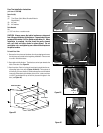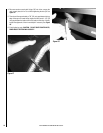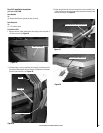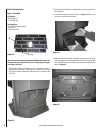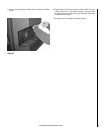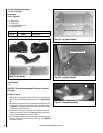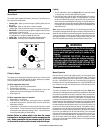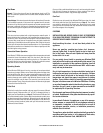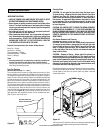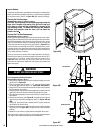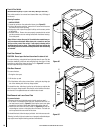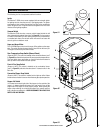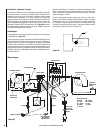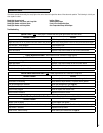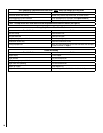
21
NOTE: DIAGRAMS & ILLUSTRATIONS ARE NOT TO SCALE.
CLEANING AND MAINTENANCE
IMPORTANT CAUTIONS:
• UNPLUG POWER CORD AND ENSURE APPLIANCE IS COLD
BEFORE PERFORMING ANY MAINTENANCE WORK.
• Some brands of pellets produce more ash and clinkers than
others. Therefore the frequency of performing the following
cleaning procedures depends to a great degree on the quality
of the pellets burned.
• Not cleaning this unit will cause it to burn poorly and will
void your warranty for this appliance.
• When removing ash build-up, use an approved ash vacuum
only. A cleaning brush can be used to loosen any ash build-up
before vacuuming. DO NOT USE A STANDARD HOUSEHOLD
VACUUM OR “SHOP VAC” AS THE FILTERS WILL LEAK THE
FINE PARTICLES OF ASH INTO THE HOME.
Required Cleaning Schedule After Number Of Bags Burned:
Burn-Pot = 10 bags
Ash Drawer = 20 bags
Flue passageways = 50 bags
Combustion Blower = 100 bags
Blower = 100 bags
Notes
• Cleaning schedule will vary depending on quality of pellets used.
Burning high ash pellets will require more frequent cleaning.
• Using a drop cloth is recommended as some ash may spill onto the
floor during the cleaning process
Burn-Pot Cleaning
(Recommended Frequency of 1 – 7 days*)
The combustion blower comes on at high speed once an hour to blow
the by-products of combustion out of the Burn-Pot. However, the Burn-
Pot should be cleaned more thoroughly after burning about 10 bags of
pellets. The Burn-Pot has a number of holes in the bottom and sides that
provide combustion air to the pellets. The extreme temperatures in the
Burn-Pot can cause the impurities in the pellets to form ash and clinkers.
When the stove is cool, open the front door and lift out the cast iron Burn-
Pot. Scrape the inner bottom and sides of the pot with a screwdriver to
remove all ash and clinkers from these surfaces. Make sure all the holes
in the pot are open. Place the Burn-Pot in the hole from which it was
removed. Make sure the high side of the pot is rotated toward the front
of the stove (see Figure 43). Push the Burn-Pot down so surface A is
tight against the steel supporting the pot. Do not substitute any other
grate or pot for use in this stove.
Figure 43
Cleaning Glass
CAUTION: Do not open the front door when the stove is hot.
To open the door, follow the first two steps listed in Front Door
Removal (see Page 24). Clean the glass using a soft cloth or
paper towel and household glass cleaner or wood stove win-
dow cleaner. A commercial glass cleaner designed for stoves
is recommended. Do not use abrasive cleaners.
A damp cloth
with a small amount of ash from the firebox can also be used
to clean the glass.
CAUTION: BE CAREFUL NOT TO ABUSE THE DOOR ASSEMBLY
BY STRIKING OR SLAMMING IT. IF THE DOOR ASSEMBLY OR
GLASS IS BROKEN OR DAMAGED, THEY MUST BE REPLACED
BEFORE HEATER CAN BE SAFELY OPERATED. USE ONLY COM-
PONENTS PROVIDED BY THE MANUFACTURER AS REPLACE-
MENT PARTS.
Ash Drawer Removal and Cleaning
(Recommended Frequency of 2 days to 2 weeks*)
CAUTION: Do not remove the ash drawer when the stove is hot.
To remove the ash drawer, swing open the left and right side
doors. Rotate the lever on latch B (see Figure 44) out from the
stove to release the ash drawer. Do the same with the latch
on the right side of the stove. Pull the ash drawer forward and
away from the stove.
CAUTION: Disposal of Ashes - Ashes should be placed in a
metal container with a tight fitting lid. The closed container
should be placed on a non-combustible floor or the ground - well
away from all combustible materials, pending final disposal. If
the ashes are disposed of by burial in soil or otherwise locally
dispersed, they should be retained in the closed container until
all cinders have been thoroughly cooled.
Reinstall the ash drawer by inserting the drawer in the stove and refasten-
ing the left and right latches securely. Note that if the ash drawer does
not seal tightly to the stove, the control board may detect a leak and
shut the stove down.
A
High Side Of Burn-Pot
Towards Front Of Insert
A
Latch
B
Figure 44
B
Latch
*Burning fuel with a high ash content or an improperly adjusted damper
may require more frequent cleaning and stove maintenance.



